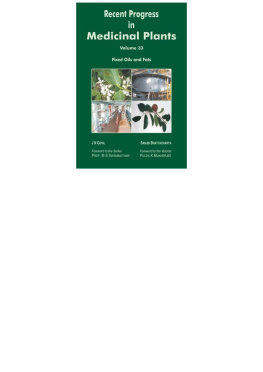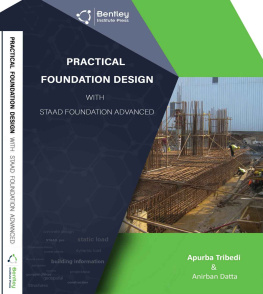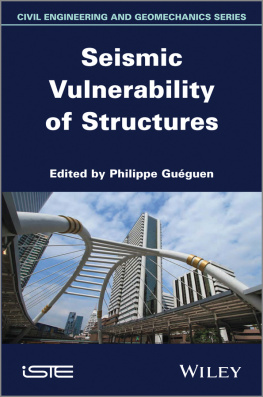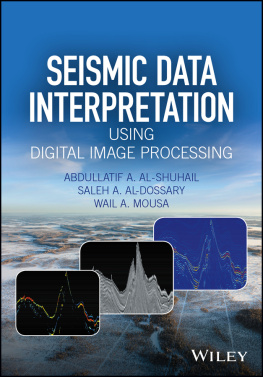Sanjib Das - STAAD.PRO CE - Seismic Analysis Using IS 1893 (PART-1)-2016
Here you can read online Sanjib Das - STAAD.PRO CE - Seismic Analysis Using IS 1893 (PART-1)-2016 full text of the book (entire story) in english for free. Download pdf and epub, get meaning, cover and reviews about this ebook. year: 2019, publisher: Bentley Institute Press, genre: Romance novel. Description of the work, (preface) as well as reviews are available. Best literature library LitArk.com created for fans of good reading and offers a wide selection of genres:
Romance novel
Science fiction
Adventure
Detective
Science
History
Home and family
Prose
Art
Politics
Computer
Non-fiction
Religion
Business
Children
Humor
Choose a favorite category and find really read worthwhile books. Enjoy immersion in the world of imagination, feel the emotions of the characters or learn something new for yourself, make an fascinating discovery.

- Book:STAAD.PRO CE - Seismic Analysis Using IS 1893 (PART-1)-2016
- Author:
- Publisher:Bentley Institute Press
- Genre:
- Year:2019
- Rating:5 / 5
- Favourites:Add to favourites
- Your mark:
- 100
- 1
- 2
- 3
- 4
- 5
STAAD.PRO CE - Seismic Analysis Using IS 1893 (PART-1)-2016: summary, description and annotation
We offer to read an annotation, description, summary or preface (depends on what the author of the book "STAAD.PRO CE - Seismic Analysis Using IS 1893 (PART-1)-2016" wrote himself). If you haven't found the necessary information about the book — write in the comments, we will try to find it.
Sanjib Das: author's other books
Who wrote STAAD.PRO CE - Seismic Analysis Using IS 1893 (PART-1)-2016? Find out the surname, the name of the author of the book and a list of all author's works by series.
STAAD.PRO CE - Seismic Analysis Using IS 1893 (PART-1)-2016 — read online for free the complete book (whole text) full work
Below is the text of the book, divided by pages. System saving the place of the last page read, allows you to conveniently read the book "STAAD.PRO CE - Seismic Analysis Using IS 1893 (PART-1)-2016" online for free, without having to search again every time where you left off. Put a bookmark, and you can go to the page where you finished reading at any time.
Font size:
Interval:
Bookmark:
Analysis Using IS 1893
(Part 1):2016
Sanjib Das

Exton, Pennsylvania, USA

Sanjib Das
Sanjib Das is a Manager at Bentley Systems, Kolkata, India. He holds a masters degree in structural engineering. He has more than 15 years of experience in dealing with critical issues in STAAD.Pro software. He is involved in providing solutions to critical structural engineering problems.
His research area includes earthquake engineering, earthquake-resistant design of RCC and steel structures, and application of software in the field of earthquake engineering. He has many national and internal publications. He has been the technical lead for the implementation of IS 1893 (Part 1):2016 in STAAD.Pro CONNECT Edition.
STAAD.Pro CE Seismic Analysis Using IS 1893 (Part 1):2016
First Edition
Copyright 2019 Bentley Systems, Incorporated. All Rights Reserved.
Bentley Systems, Incorporated
685 Stockton Drive
Exton, PA 19341, United States of America
www.bentley.com/books
Printed in the United States of America
Bentley, B Bentley logo, Bentley Institute Press and MicroStation are either registered or unregistered trademarks or servicemarks of Bentley Systems, Incorporated or one of its direct or indirect wholly owned subsidiaries. Other brands and product names are trademarks of their respective owners.
The publisher does not warrant or guarantee any of the products described herein or perform any independent analysis in connection with any of the product information contained herein. The publisher does not assume, and expressly disclaims, any obligation to obtain and include information other than that provided to it by the manufacturer.
The reader is expressly warned to consider and adopt all safety precautions that might be indicated by the activities herein and to avoid all potential hazards. By following the instructions contained herein, the reader willingly assumes all risks in connection with such instructions.
The publisher makes no representation or warranties of any kind, including but not limited to, the warranties of fitness for particular purpose of merchantability, nor are any such representations implied with respect to the material set forth herein, and the publisher takes no responsibility with respect to such material. The publisher shall not be liable for any special, consequential or exemplary damages resulting, in whole or part, from the readers use of, or reliance upon, this material.
Library of Congress Control Number: 2019947064
ISBN: 978-1-934493-58-8
| Published by: Bentley Institute Press Bentley Systems, Incorporated 685 Stockton Drive Exton, PA 19341, United States of America |
This book is dedicated to all the users of STAAD.Pro who have used it for their projects over the years. The feedback and support of our users over the years have driven this project. Fundamentally what we love to do is create, so it is wonderful watching the product and its users grow!
Last year we had an idea of helping our users get a better understanding of STAAD.Pro CE Seismic Analysis. To accomplish this, we planned to write a text to cover seismic design criteria as per Indian standard, the process of using different parameters required for equivalent static and dynamic analyses. Our problem was tractable because recent earthquakes in India indicate that many of collapses of buildings were due to lack of considerations of the basic concepts of earthquake behaviour in design.
STAAD.Pro CE Seismic Analysis using IS 1893 (Part 1):2016 was the fruit of months of effort of multiple Bentley colleagues and of course our users. Firstly, we would like to thank our author Sanjib Das who made it happen. Information about the author is provided in the section About the Author. We would also like to thank Shreyanka Bhattacharjee and Aritra Lodh for their commitment to collaborate and help the author with the manuscript. Many engineers, technical support representatives and product specialists at Bentley Systems reviewed the chapters and accompanying examples to provide valuable inputs and to shape the text into its current form.
Vikash Pandey
Manager at Bentley Institute Press
Global urbanization, concentrating populations in large coastal cities, has resulted in more than half the worlds population who are now susceptible to one or more natural hazards. In India, three of the four largest cities lie in seismic zone IV subject to some of the highest earthquake loading and risk. The risk to life and limb is just one consideration, with so many people concentrated in such close proximity in large cities. The importance of ensuring resilience in their infrastructure is greater than ever. Over the last couple of decades, more than 200,000 lives and 4,000,000,000,000 in USD direct and indirect economic losses can be attributed to earthquakes (Munich RE). The ability of our communities and society to react and recover for earthquakes has become as much of consideration in our design codes as the need to keep the population safe.
Structural seismic design codes evolve with lessons learned in each major earthquake experience. Early codes adapted to the poor performance of irregular and discontinuous structures adding higher strength and ductility requirements. More recent events have highlighted the need to consider vertical accelerations and the secondary loading impacts that result from structure weight acting on a deformed structure. Minimum design forces and ductility factors have been adjusted as we learn more about near- and far-field seismic loading characteristics along with increasing resilience requirements as more buildings need to be designed not just to ensure life safety but also with intent to return to operation soon after seismic events.
The design codes have also adapted to technological advancements, allowing us to continuously improve the way we idealize and simulate the behaviour and performance of our buildings subject to seismic forces. When Amit Das started Research Engineers International in 1981, wrote STAAD, one of the first STructural Analysis And Design software solutions for the PC, he created the foundation for improving the productivity of engineers and our ability to more accurately simulate the performance on thousands of structures analysed and designed with STAAD in the last four decades. STAAD.Pro CONNECT Edition today has continued to stay up to date in the implementation of the myriad of the latest IS 1893 analysis and design code requirements, and the need to understand the application of code requirements in the software engineers use is more important than ever.
It is with this purpose that Sanjib Das has written this formative book on the basis of the evolution and application of the latest IS 1893 design code in STAAD.Pro. The book provides an overview of science of earthquake engineering from source causes to measurement standards. Sanjib takes readers through a short history of the origins and organization of structural design standards and identifies the latest changes made in the IS 1893 Seismic Standard. In the core, Sanjib does an exceptional job describing the various analysis techniques, static, dynamic, linear, nonlinear prescribed by the code, providing an excellent balance of the technical with the practical application in STAAD.Pro CONNECT Edition. It is clear that Sanjibs extensive engineering and STAAD experience have provided a practical guide and filter to present and interpret the design code intent gained though his close interaction with members of the design code committee.
Font size:
Interval:
Bookmark:
Similar books «STAAD.PRO CE - Seismic Analysis Using IS 1893 (PART-1)-2016»
Look at similar books to STAAD.PRO CE - Seismic Analysis Using IS 1893 (PART-1)-2016. We have selected literature similar in name and meaning in the hope of providing readers with more options to find new, interesting, not yet read works.
Discussion, reviews of the book STAAD.PRO CE - Seismic Analysis Using IS 1893 (PART-1)-2016 and just readers' own opinions. Leave your comments, write what you think about the work, its meaning or the main characters. Specify what exactly you liked and what you didn't like, and why you think so.









